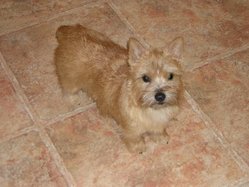Norwich Terrier
The Norwich Terrier is the smallest of the Terriers that was bred to hunt small vermin. more...
Appearance
These terriers are among the smallest terriers (11-12 lbs, 5 to 5.4 kg; 9 to 10 inches (24 to 25.5 cm) at the withers), with prick ears and a double coat. In its earliest history, it was also known as the Jones Terrier and the Cantab Terrier. It was developed in East Anglia in England.
Temperament
These small but hardy teddy bears are courageous, remarkably intelligent and wonderfully affectionate. They can be assertive but they are never aggressive or quarrelsome. They are energetic and thrive on an active life but won't be any worse for wear if they miss a day's exercise now and then. They are easy to train and eager to please. They are sensitive to scolding but 100% Terrier. They should never be kept outside or in a kennel setting because they love the companionship of their owners too much. Norwich are not given to unnecessary barking but they will warn of a stranger approaching. When brought in to the home as a puppy they quickly accept other pets and love children. Males often make the best companions though are a little more sensitive to changes in routine than females. Most important is that Norwich do not have a road sense and hence need to be kept on lead when there are being walked. Norwich seem to prefer the company of humans over other dogs, though they readily accept their heritage of being pack dogs.
History
The breed has existed since at least the late 1800s, as working terrier of East Anglia, England. The game and hardy little dogs were useful as ratters in the stable yard, bolters of fox for the hunt, and loving family companions. It was the mascot of students at Cambridge University. Small red terriers, descendants of Irish Terriers, had existed in the area since at least the 1860s, and these might be the ancestors of the Norwich, or it might have come from the Trumpington Terrier, a breed that no longer exists.
Since its earliest identification as a breed, puppies have had either drop or prick ears, and both were allowed when the Norwich was first recognized in the show ring in 1932 by The Kennel Club (England). Drop ears were often cropped until it became illegal to do so. This intensified a long-standing controversy over whether drop-eared dogs should be allowed in the show ring and whether the primary difference was simply the ears or whether other, deeper, personality and structural differences marked the drop-eared variety. Starting in the 1930s, breeders increased their efforts to distinguish the breeds.
Both ear types continued to be allowed in the ring until The Kennel Club recognized the drop-eared variety as a separate breed, the Norfolk Terrier, in 1964, and the American Kennel Club and Canadian Kennel Club did the same in 1979.
Read more at Wikipedia.org



